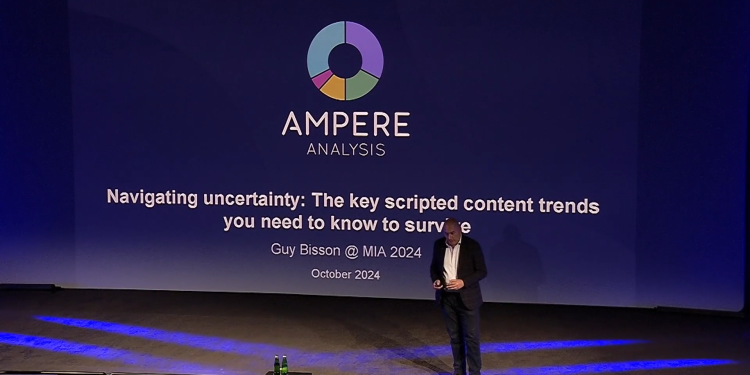At the MIA – International Audiovisual Market held in Rome from 14-18 October, Guy Bisson, a key analyst from Ampere Analysis, delivered an insightful 25-minute keynote titled Navigating Uncertainty: The Key Scripted Content Trends You Need to Know to Survive.
As the global scripted television landscape encounters significant obstacles, Bisson explored how both international streaming platforms and local broadcasters are evolving their content strategies. He identified major market transitions and the opportunities that persist amid these challenges.
Reflecting on recent years, Bisson noted that the market has undergone significant saturation, accompanied by a retreat from major investors. This trend has resulted in workforce reductions, decreased commissioning rates, and a pivot towards diversified revenue streams, including ad-supported models that prioritise profitability over expansion
The end of the “peak TV” era is traced back to Q2 2021. In the past four years, the global audiovisual sector has grappled with extraordinary crises, including the COVID-19 pandemic, a retreat from investment by global streamers, and the SAG-AFTRA strikes of 2023. Bisson highlighted that these factors have particularly impacted scripted programming, stating:
If a recession is characterised by two consecutive quarters of negative growth, then the US scripted industry entered a recession in mid-2022 and has yet to see a full recovery.
He further compared the current situation to the media-specific recession following the dot-com crash in 2002, suggesting there is reason for cautious optimism this time. Europe lagged behind the USA, experiencing its own downturn in Q2 2023.
The most significant reductions in spending have been in the higher-cost scripted genres, including children’s programming (which is increasingly licensed), horror, action, and sci-fi. In contrast, genres such as romance, crime, comedy, and drama continue to flourish. The pandemic and strikes have also catalysed a trend toward safer renewals over first-time productions.
“So, the new reality is that growth in spending isn’t on the horizon,” Bisson cautioned. He presented data indicating that global content expenditure is expected to rise by only 0.2% (CAGR, or compound annual growth rate) from 2022 to 2029, reaching a total of $180 billion. This is a stark contrast to the CAGR of 6% observed from 2012 to 2022.
In Western Europe, scripted series orders for H1 2024 reveal that crime and thriller genres dominate, accounting for 39%, followed by comedy (18%), children’s programming (16%), drama (16%), romance (7%), and sci-fi (2%). Crime series are predominantly commissioned by public broadcasters (50%) and SVoD platforms (24%), with commercial free-to-air channels contributing 18%.
Bisson predicts a recovery may already be underway in the USA. First-run scripted series orders by major US networks in Q3, while still below previous highs, have surged by 73% compared to the strike period. Notably, global streamers are shifting their focus from the US market toward Asia and Europe. Currently, 34% of first-run scripted commissions from Netflix and Amazon originate in Western Europe, followed by 31% from the Asia Pacific region. The two giants primarily order crime and thriller (47%), comedy (20%), and drama (15%).
Bisson emphasised a notable shift towards commissioning “safe” global languages, stating:
While English and Spanish continue to gain traction due to their vast user bases, there has been a dramatic decline in commissioning for French, German, Italian, and Nordic languages.
In conclusion, the era of “peak TV” has definitively passed, and there are few indicators of a robust recovery in either the USA or Europe. The high costs associated with scripted content are increasingly challenging within the current economic climate, prompting a movement toward lower-cost dramas. Simultaneously, licensing is re-emerging as a significant force, as streamers seek to compensate for diminished investments in scripted programming with quality content that has succeeded on smaller broadcasting platforms. Notably, spending on licensing is projected to increase by over 12% in the coming five years, creating substantial opportunities for the right types of catalogue content.
Streamers are now embracing licensed drama to fill gaps left by reduced spending on original productions, offering new life to rights holders and accepting shorter release windows.
Europe stands to benefit the most from commissioning activity, with ongoing investments in crime, comedy, and key sub-genres of drama, including historical, sports, and military-themed narratives. Additionally, co-production prospects are anticipated to grow in Asia and later in the MENA region, opening fresh creative avenues.
Finally, advertising is emerging as the primary growth driver for streaming services, influencing commissioner demands. The landscape of streaming is becoming increasingly broadcast-like, prioritising long-term audience engagement over immediate customer acquisition. Advertising revenue is expected to exceed subscription income by at least 20% within the next five years, contributing to a faster recovery for the sector.














